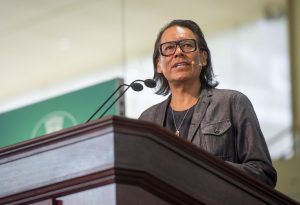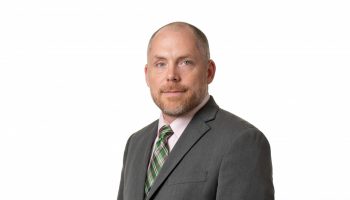
As director of Sundance Institute’s Indigenous Program, N. Bird Runningwater travels the world in order to amplify indigenous stories. Ultimately, he wants all Americans to see these stories on their movie screens, as well as in their textbooks.
“I really feel like there’s still a lot of history, a lot of wisdom, a lot of culture and a lot of perspective — especially from those of us coming from matrilineal, matriarchal societies — that can contribute to the learning and ongoing development of our country and society,” Runningwater said.
At 10:45 a.m. on Wednesday in the Amphitheater, Runningwater gave his lecture on “Indigenous Perspectives on Cinema” as part of Week Nine, “Exploring Race and Culture with Wynton Marsalis and Jazz at Lincoln Center.”
“At this point, what I call my life’s work has been dedicated towards really dismantling this notion of invisibility that we, as indigenous people to North America, seem to exist within in our larger American media and popular culture system,” he said.
His work has also been dedicated to exploring representation, but also “dismantling the history of misrepresentation.”
Before introducing Chautauquans to generations of indigenous filmmakers and artists, Runningwater began his lecture with a background of his ancestry, with a geographic range that spans the entirety of North America.
On his father’s side, Runningwater’s Chiricahua great-grandfather was born as a prisoner of war in Vernon, Alabama. Upon release in 1930, the Chiricahua were told they could share land with the Mescaleros in New Mexico, but they could not return to their ancestral land. In a similar vein, Runningwater’s maternal great-great-grandmother, White Buffalo Woman, was forcibly relocated from Colorado to the Cheyenne land in Oklahoma.
Runningwater was raised on the Mescalero Apache Reservation in New Mexico, and grew up speaking Cheyenne and Apache. Recently he returned, for a 12-day, coming-of-age ceremony, to sing young women into womanhood.
“We sing all of our songs going back to the creation of the universe and the Earth from the Apache perspective, going back to our first person who was created, … White Painted Woman,” he said. “These young women basically reenact her life, and they’re given that honorary title during that ceremony.”
According to Apache belief, White Painted Woman’s two twin sons told the Apache to migrate south from Alaska, to where the tribe settled near the present-day U.S.-Mexico border.
“I think under today’s immigration policies, we probably wouldn’t be let into the country, even though it’s our own land,” he said.
Unfortunately, Runningwater said that this Apache story is not communicated in American education systems or in cinematic history.
Runningwater’s desire to communicate indigenous stories is shared with his boss and Sundance Institute founder Robert Redford, who purchased the land in Utah that would later host the Sundance Resort after he was asked to audition for a Native American television role.
“(Redford) was particularly appalled by that, and so it kind of led him on a personal quest,” Runningwater said.
Redford began inviting Native filmmakers, writers, directors and actors to meet and discuss filmmaking. Together, with Chris Spotted Eagle and Larry Littlebird, among other collaborators, the Sundance Institute was born.
For the first 20 years, Runningwater said Sundance struggled to gain traction with indigenous work.
“It was around 1992 when they finally brought on Native staffers who had relationships with Native communities to carry out the work,” he said. “That’s when it really took off with creating very specific workshops and labs to support Native filmmakers.”
Now, Sundance has cultivated four “generations” of Native filmmakers.
The first generation, which includes Spotted Eagle and Littlebird, largely focused on documentaries because filmmakers could secure funding from the Public Broadcasting Service and other organizations.
“They all had aspirations to eventually work in fiction film,” Runningwater said. “Of all these people, only one, Merata Mita from New Zealand … she’s the only Māori woman in New Zealand to direct a dramatic feature film.”
The second generation of Native filmmakers saw more fiction films, such as “Grand Avenue” by Greg Sarris and “Smoke Signals” by Sherman Alexie and Chris Eyre. The latter’s script was rejected six times before Sundance finally agreed to film and finance the project. “Smoke Signals” went on to become the second-highest-grossing independent film of 1998, and won the Filmmaker’s Trophy and Audience Award at Sundance Film Festival.
“Smoke Signals” served as a major inspiration for the third generation of Native filmmakers. As members of this third generation began their filmmaking journeys, Runningwater joined Sundance and broadened the Indigenous Program to support more filmmakers from around the world.
Two notable filmmakers from this third generation are Seminole-Mvskoke director Sterlin Harjo, who directed “Four Sheets of the Wind” and “Barking Water,” and Māori director Taika Waititi from New Zealand, who directed “Eagle vs Shark” and “Boy” before being tapped by Marvel Studios to direct “Thor: Ragnarok” in 2017.
“These two scenarios are ideal for us in terms of our position as filmmakers,” Runningwater said. “We can identify them at the short film stage, give them an interesting script, put them through the Sundance writer’s lab incubation process, spit them out the other end with a feature film and then, ideally, the industry would take notice.”
Another example from the third generation is Sydney Freeland, a Navajo, or Diné, trans woman who directed “Drunktown’s Finest” and recently directed episodes of ABC’s “Grey’s Anatomy.”
“That’s a major accomplishment, I think, to have a Navajo director have two prime time episodes of episodic TV on a major network,” he said.
The fourth generation of Native filmmakers has been focusing on short-form content and has pushed Sundance to explore immersive media projects, including virtual reality storytelling.
“They’ve grown up with technology, but they’re also balancing a commitment to their culture, a commitment to language, but also a commitment to technology,” Runningwater said. “They’re really unlike any generation, I think, that has come about, so we’ve really been able to create some great work.”
The fourth generation is also the first, Runningwater said, to predominantly feature women.
Among these female filmmakers are Amanda Kernell, a Southern Sami director from Sweden; Peshawn Bread, a Comanche director who is currently working on a film about a Native dominatrix; and Ciara Lacy, a Native Hawaiian director whose documentary “Out of State” examines how Native Hawaiians have reconnected with their culture while in prison in Arizona.
While Sundance has helped foster greater indigenous representation in film, Runningwater said there is still a long way to go to combat a canon of misrepresentative cinema.
“Our indigenous filmmakers carry much more of a burden than other filmmakers do, because we have 100-plus years worth of cinema that we have to deconstruct in our work,” he said. “But then we also have to create something authentic and innovative and new.”
According to a study conducted by IllumiNatives, a nonprofit dedicated to authentic depictions of Native communities in popular culture, between 0% and 0.4% of all characters in prime time television are Native American. Furthermore, 87% of state-level history education standards fail to cover Native people in a post-1900 context.
“So basically, we’re erased from history books, and we’re also erased from the screens,” Runningwater said. “I fan the flames of creativity, and I’m cheerleading and encouraging our young talent to keep going and fighting against the system, (so they know) there are these opportunities that they can really create something new and help contribute to the cultural fabric of this country.”
Another challenge for Native filmmakers, he said, is convincing film distributors that there is an audience interested in Native stories.
“A lot of times they’re part of those people who have come from this education process where we haven’t been represented, and so they look at an indigenous film and are at a complete loss,” Runningwater said.
Fortunately, Runningwater said digital platforms like Netflix have helped Native filmmakers somewhat circumvent this hurdle. Additionally, Runningwater was recently invited to join the Academy of Motion Picture Arts and Sciences; in the role, he would be granted an Oscars voting position, as well as a voice in the nomination process.
“I think I’ve had seven filmmakers that have come through my program that have also been invited to join the Academy, so the steps are incremental,” he said. “They’re small, but we’re all on the same page. It’s kind of a given value that so many of our indigenous filmmakers, not only in the United States, … continue to fight to be represented in our own countries.”




